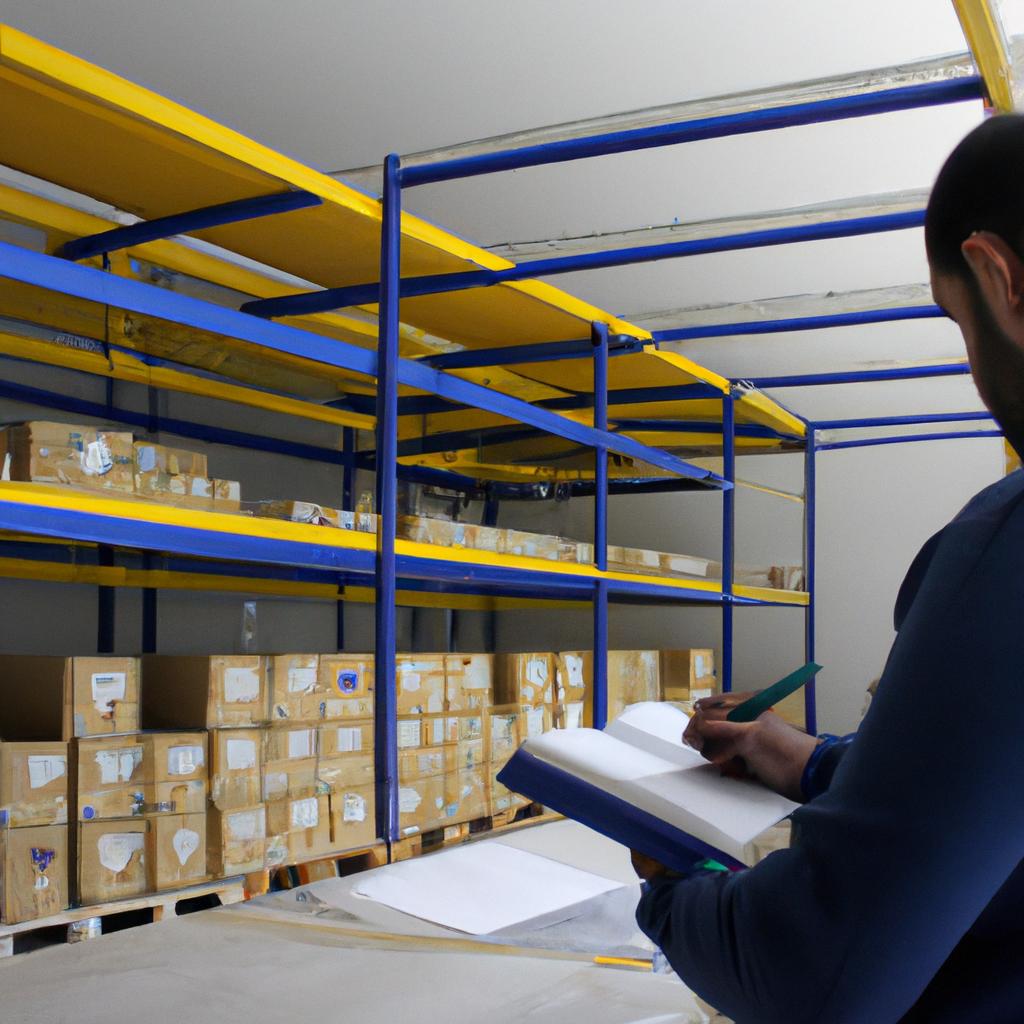In today’s dynamic business environment, transportation and logistics play a critical role in ensuring the smooth flow of goods from suppliers to consumers. However, with this intricate process comes the inevitable occurrence of product returns. A well-defined return policy is essential for streamlining reverse logistics operations, minimizing costs, and enhancing customer satisfaction. For instance, imagine a scenario where an e-commerce giant receives a high volume of returned items due to wrong sizes or damaged products. Without an efficient return policy in place, such as clear guidelines on return procedures and timeframes, companies may face significant challenges in managing these returns effectively.
Effective management of reverse logistics requires careful planning and robust policies that address various aspects of the process. This article aims to explore the importance of having a streamlined return policy in transportation and logistics and its impact on improving efficiency within supply chain networks. By examining real-world examples and hypothetical scenarios, we will delve into key factors that contribute to an effective return policy implementation. Additionally, this article will discuss strategies for optimizing reverse logistics processes through improved communication channels between customers, suppliers, carriers, and other stakeholders involved.
With rising consumer expectations regarding hassle-free returns and exchanges, it becomes imperative for companies operating in the transportation and logistics industry to establish comprehensive policies governing reverse logistics operations. By By doing so, companies can provide clear guidelines to customers on how to initiate returns, what conditions must be met for a successful return, and the timeframe within which returns are accepted. This clarity not only helps customers understand the process but also reduces confusion and frustration, leading to improved customer satisfaction.
A streamlined return policy also enables companies to efficiently manage the handling of returned items. By implementing standardized procedures for inspecting and processing returns, companies can quickly determine whether products should be restocked, repaired, or discarded. This helps minimize delays in inventory management and ensures that returned items are handled promptly and appropriately.
Furthermore, an effective return policy allows companies to identify patterns or trends in product returns. By closely analyzing the reasons behind returns, companies can gain valuable insights into potential quality issues or areas for improvement in their supply chain processes. For example, if a significant number of returns are due to damaged packaging during transportation, it may indicate the need for better packaging materials or improved handling instructions for carriers.
In addition to improving operational efficiency, a well-defined return policy can also have a positive impact on cost management. By establishing clear guidelines on who bears the cost of return shipping and whether restocking fees apply, companies can ensure that they are not absorbing unnecessary expenses associated with product returns. This helps maintain profitability while still addressing customer needs.
Overall, having a streamlined return policy is crucial for transportation and logistics companies to effectively manage reverse logistics operations. It provides clarity to customers regarding return procedures, improves operational efficiency by standardizing processes, enables data-driven analysis of return patterns, and contributes to cost management efforts. As consumer expectations continue to evolve in terms of hassle-free returns and exchanges, implementing an efficient return policy becomes even more critical for businesses operating in this industry.
Importance of Return Policies in Transportation and Logistics
Return policies play a crucial role in the transportation and logistics industry. They serve as guidelines that facilitate the smooth process of reverse logistics, which involves handling return shipments from customers back to the supplier or manufacturer. To illustrate this importance, let us consider the case of an online retailer specializing in electronics.
Imagine a customer purchases a laptop from this retailer but encounters an issue with it upon delivery. In such cases, having a clear and efficient return policy is essential for both the customer and the company. The customer needs reassurance that they can easily initiate a return request and receive a refund or replacement promptly. On the other hand, the retailer benefits from being able to efficiently manage returned items, minimize losses, and maintain customer satisfaction.
A well-defined return policy provides several advantages in transportation and logistics:
- Customer confidence: By offering transparent and user-friendly return policies, companies can build trust with their customers. This leads to increased customer satisfaction, repeat business, positive word-of-mouth referrals, and ultimately better brand reputation.
- Efficient operations: A streamlined return policy allows companies to handle returns more effectively by providing clear instructions on how to initiate returns, specifying acceptable conditions for returns (e.g., unopened packaging), defining timeframes for returning items, and outlining any associated costs or fees.
- Reduced financial impact: Implementing effective return policies enables businesses to mitigate potential financial losses caused by returned merchandise. Clear guidelines help identify defective products sooner, allowing them to be repaired or replaced under warranty before further damage occurs.
- Sustainable practices: Well-managed reverse logistics processes promote sustainability by reducing waste through refurbishing or recycling returned items when possible. This not only minimizes environmental impact but also contributes positively towards corporate social responsibility efforts.
| Advantages of Effective Return Policies |
|---|
| – Increased customer confidence |
| – Efficient operational management |
| – Minimized financial impact |
| – Promotion of sustainable practices |
Recognizing the importance of return policies in transportation and logistics, it is crucial for companies to invest time and resources into developing comprehensive policies that cater to their specific industry needs. In the following section, we will explore the challenges faced by businesses when handling returns in this dynamic field.
Transitioning into the subsequent section on “Challenges Faced in Handling Returns in the Transportation and Logistics Industry,” it becomes evident that despite the benefits offered by well-defined return policies, numerous obstacles must be overcome to ensure efficient reverse logistics processes.
Challenges Faced in Handling Returns in the Transportation and Logistics Industry
In order to better understand the challenges faced in handling returns in the transportation and logistics industry, it is essential to recognize the significance of return policies. Let us consider a hypothetical scenario where an online retailer has implemented a well-structured return policy. A customer purchases a product but later discovers that it does not meet their expectations or requirements. With an efficient return policy, the customer can easily initiate the return process, resulting in a smooth experience for both parties involved.
Handling returns in transportation and logistics can be complex due to various reasons. One challenge is ensuring timely and accurate tracking of returned items throughout the reverse logistics process. This involves monitoring the movement of goods from customers back to warehouses or distribution centers. Additionally, companies must manage inventory effectively during this period, as returned items may need to be inspected, repaired if necessary, and then reintroduced into stock.
To further comprehend these challenges, let’s examine some key factors that contribute to the complexity of handling returns:
- Customer Satisfaction: Providing a hassle-free return experience contributes significantly to overall customer satisfaction levels.
- Cost Management: The costs associated with processing returns include transportation expenses, inspection costs, refurbishment or disposal fees for damaged products, as well as potential revenue losses.
- Inventory Control: Managing returned items within existing inventory systems requires careful organization and tracking mechanisms.
- Environmental Impact: Reverse logistics processes should also consider environmental sustainability by minimizing waste generation through appropriate recycling or disposal methods.
The following table illustrates how each factor impacts the handling of returns in transportation and logistics:
| Factors | Challenges Faced |
|---|---|
| Customer Satisfaction | Ensuring ease-of-use for customers when initiating returns |
| Cost Management | Minimizing financial impact while providing quality service |
| Inventory Control | Efficiently integrating returned items into existing stock |
| Environmental Impact | Promoting sustainable practices throughout the process |
In summary, return policies play a crucial role in ensuring customer satisfaction and streamlining reverse logistics operations. The challenges faced in handling returns are multifaceted, including factors such as customer satisfaction, cost management, inventory control, and environmental impact. By addressing these challenges effectively, transportation and logistics companies can enhance their overall performance and provide better service to their customers.
Transitioning from this discussion on the importance of return policies, the subsequent section will delve into the benefits that arise from streamlining return processes in transportation and logistics. This examination will shed light on how optimizing these procedures can lead to improved efficiency and operational effectiveness.
Benefits of Streamlining Return Processes in Transportation and Logistics
Transportation and logistics companies often face numerous challenges when it comes to handling returns. One example that illustrates these challenges is a case study of a global e-commerce company that sells various products online. This company receives a significant number of product returns due to customer dissatisfaction, damaged goods during transit, or incorrect deliveries.
To streamline return processes in transportation and logistics, several key benefits can be achieved. Firstly, efficient return management helps improve customer satisfaction by providing a hassle-free experience for customers who need to return their purchases. By implementing streamlined processes, companies can reduce the time taken for customers to initiate and complete returns, thereby enhancing overall customer experience.
Secondly, streamlining return processes can lead to cost savings for transportation and logistics companies. By optimizing reverse logistics operations, companies can minimize costs associated with processing returns, such as labor expenses, inventory holding costs, and shipping fees. Additionally, reducing the time spent on managing returns allows employees to focus on other essential tasks within the organization.
Lastly, effective return management contributes to sustainability efforts in the transportation and logistics industry. Implementing environmentally friendly practices like recycling or refurbishing returned products reduces waste generated from returned items. Companies can also explore options for reselling or donating usable returned products instead of disposing of them entirely.
These benefits highlight the significance of streamlining return processes in transportation and logistics. By improving customer satisfaction, reducing costs, and promoting sustainability, companies can enhance their overall operational efficiency and competitiveness in this ever-evolving industry.
Transition into subsequent section: To achieve an efficient return management system in transportation and logistics, it is essential to implement strategies that address common challenges faced by businesses in this field.
Strategies for Efficient Return Management in Transportation and Logistics
Section H2: Strategies for Efficient Return Management in Transportation and Logistics
Streamlining return processes in transportation and logistics is crucial to effectively manage reverse logistics. In order to achieve this, companies must adopt strategies that optimize the overall return management system. By implementing these strategies, organizations can minimize costs, enhance customer satisfaction, and improve operational efficiency.
One effective strategy is to establish clear communication channels with customers regarding the return process. Providing customers with detailed instructions on how to initiate a return and what information is required helps streamline the entire procedure. For instance, let us consider a hypothetical case study involving an e-commerce company that specializes in selling electronic gadgets. The company could implement an online portal where customers can easily request returns by filling out a simple form and uploading supporting documents such as purchase receipts or product images.
Another important aspect of efficient return management is ensuring timely processing of returned items. Establishing dedicated teams or departments responsible for handling returns can help expedite the process. Additionally, automating certain stages of the return management process through advanced software systems can further accelerate turnaround time. To illustrate this point, consider the following bullet point list highlighting key benefits of streamlining return processes:
- Reduced lead times for processing returns
- Improved inventory accuracy through automated tracking
- Enhanced visibility into product defects or quality issues
- Increased trust and loyalty from customers due to hassle-free returns
Furthermore, deploying technology-driven solutions aids in data collection and analysis throughout the reverse logistics cycle. This enables organizations to identify patterns or trends related to returned products, which can be invaluable for making informed decisions regarding supplier selection, packaging improvements, or preventive measures against future returns. A three-column table provides a visual representation of some commonly collected data points during the return management process:
| Data Point | Purpose | Example |
|---|---|---|
| Reason for Return | Identify common issues with products | Damaged item |
| Return Location | Analyze geographical return patterns | Metro areas vs. rural locations |
| Return Condition | Assess product quality and packaging | Opened box, missing accessories |
By capitalizing on these strategies, companies can achieve significant benefits in terms of cost savings, customer satisfaction, and operational efficiency. Implementing efficient return management practices ultimately creates a positive impact on the overall supply chain ecosystem.
Technological advancements facilitating smooth reverse logistics play a vital role in enhancing the effectiveness of return processes in transportation and logistics.
Technological Advancements Facilitating Smooth Reverse Logistics
In the previous section, we explored the various strategies that can be implemented to ensure efficient return management in transportation and logistics. Now, let us delve deeper into how technological advancements have facilitated smooth reverse logistics.
To illustrate this point, consider a hypothetical scenario where a customer purchases a defective product online and wishes to return it. In the past, this process would involve multiple phone calls or emails to initiate the return, followed by manual coordination between the customer, retailer, and carrier. However, with modern technology, such as automated return portals integrated within e-commerce platforms, customers can now initiate returns directly through an online interface. This streamlines the entire process by eliminating unnecessary communication steps and reducing errors.
Technological advancements have not only improved the initiation of returns but also transformed other aspects of reverse logistics. Here are some key ways technology has facilitated smoother return management:
- Real-time tracking systems: Advanced tracking technologies provide accurate visibility throughout the return journey from the customer back to the retailer or manufacturer. This helps identify potential bottlenecks or delays and allows proactive measures to be taken.
- Data analytics tools: By leveraging big data analytics, companies can gain valuable insights into their return patterns. These insights enable them to optimize processes, reduce costs associated with returns, and even make improvements in product design or quality control.
- Automated sorting systems: Technological innovations have led to the development of automated sorting systems capable of efficiently categorizing returned items based on their condition (e.g., resaleable, repairable) or destination (e.g., recycling centers). This significantly speeds up processing times while ensuring appropriate actions are taken for each item.
- Communication platforms: Integrated communication platforms allow seamless collaboration among all stakeholders involved in reverse logistics – customers, retailers/ manufacturers, carriers – enabling real-time updates and effective resolution of any issues that may arise during the return process.
These advancements highlight how technology has revolutionized the way return management is handled in transportation and logistics. By leveraging these tools, companies can streamline their reverse logistics processes, leading to cost savings, improved customer satisfaction, and reduced environmental impact.
Case Studies Demonstrating Successful Implementation of Return Policies in Transportation and Logistics
Having explored the technological advancements that have paved the way for streamlined reverse logistics, we now turn our attention to real-world examples demonstrating the successful implementation of return policies within transportation and logistics. One such case study involves a global e-commerce giant that has utilized innovative return processes to enhance customer satisfaction and optimize their supply chain.
Case Study: Enhancing Customer Experience through Efficient Returns
One prominent example is Amazon’s return policy, which prioritizes convenience for its customers while simultaneously managing operational efficiency. By allowing flexible returns through various channels – including drop-off locations, designated carrier pickups, or even self-service kiosks – Amazon ensures a hassle-free experience for consumers seeking to return products. This approach not only improves customer satisfaction but also minimizes costs associated with processing returns by reducing shipping distances and streamlining inventory management.
To further understand how effective return policies can positively impact businesses within transportation and logistics, let us delve into key factors that contribute to their success:
-
Clear Communication Channels:
- Providing accessible information regarding return procedures.
- Offering multiple communication options (phone, email, chat) for addressing customer queries promptly.
- Utilizing user-friendly online platforms to simplify the initiation of returns.
-
Simplified Packaging Requirements:
- Clearly outlining packaging instructions to facilitate efficient handling.
- Implementing standardized guidelines across different product categories.
- Utilizing sustainable packaging materials to align with environmental initiatives.
-
Speedy Refund Processes:
- Ensuring prompt reimbursement upon receipt of returned items.
- Employing automated systems that expedite refund approvals.
- Communicating transparently about refund timelines to manage customer expectations effectively.
-
Continuous Feedback Loop:
- Encouraging customers to provide feedback about their return experiences.
- Actively monitoring and analyzing customer feedback to identify improvement opportunities.
- Implementing necessary changes based on the collected data to refine return policies.
Table: Customer Satisfaction Levels Based on Return Policy Implementation
| Aspect | High Level of Satisfaction | Moderate Level of Satisfaction | Low Level of Satisfaction |
|---|---|---|---|
| Clear Communication Channels | :heavy_check_mark: | ||
| Simplified Packaging | :heavy_check_mark: | ||
| Speedy Refund Processes | :heavy_check_mark: | ||
| Continuous Feedback Loop | :heavy_check_mark: |
By considering these key factors, businesses can enhance customer satisfaction, build trust, and differentiate themselves in an increasingly competitive market. Successful implementation of effective return policies not only improves overall supply chain efficiency but also allows organizations within transportation and logistics to cultivate enduring relationships with their customers.
Incorporating best practices from case studies such as Amazon’s approach can serve as a blueprint for other companies seeking to optimize their reverse logistics processes. By prioritizing consumer needs through clear communication channels, simplified packaging requirements, speedy refund processes, and maintaining a continuous feedback loop, businesses can achieve greater operational efficiency while ensuring customer satisfaction remains at the forefront.









